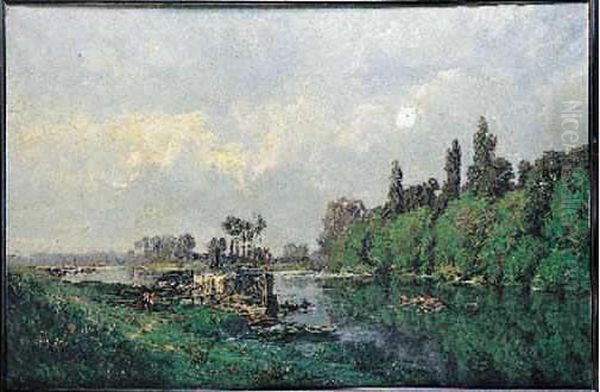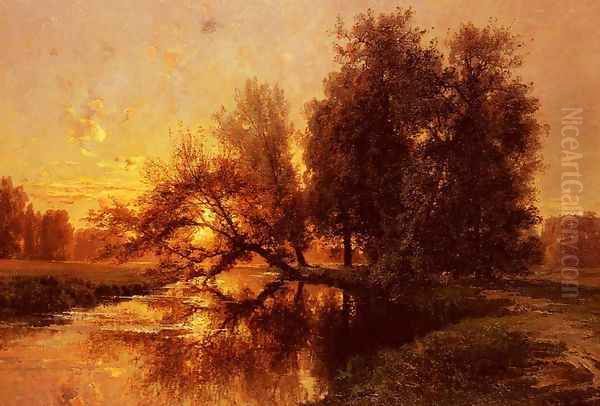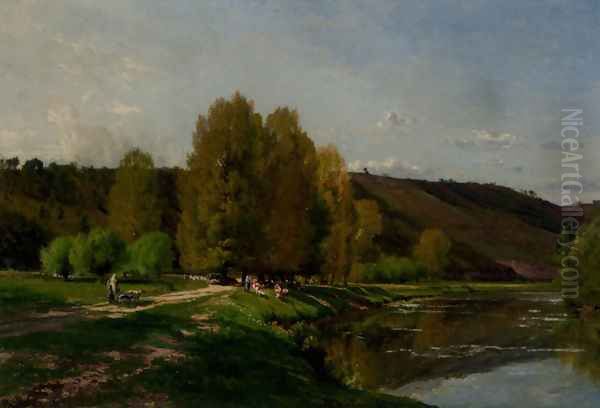Alexandre René Veron stands as a notable figure within the rich tapestry of 19th-century French art. Born in 1826 and passing away in 1897, Veron dedicated his artistic life primarily to landscape painting, capturing the subtle beauties and enduring character of the French countryside during a period of significant artistic transformation. Though perhaps not as globally renowned as some of his contemporaries, his work possesses a distinct charm and technical skill that earned him recognition during his lifetime and ensures his place in the annals of French art history.
His journey as an artist began under the tutelage of a significant figure in the academic art world, Paul Delaroche. Delaroche was celebrated for his historical paintings, often dramatic and meticulously detailed. Studying under such a master provided Veron with a strong foundation in drawing and composition, even though his own artistic path would diverge significantly from his teacher's focus on historical narratives. Veron chose the landscape, the open air, and the quiet poetry of nature as his primary subjects.
Early Career and the Salon Debut
The year 1848 marked a pivotal moment for both France and for Alexandre René Veron. As the nation navigated the political shifts of the Second Republic, Veron made his official debut at the prestigious Paris Salon. The Salon was the paramount venue for artists seeking recognition and patronage in 19th-century France. Acceptance and exhibition there were crucial steps towards building a successful career.
Veron's debut coincided with a growing appreciation for landscape painting in France. For decades, the French Academy had prioritized historical, religious, and mythological subjects – the so-called "grand genre." Landscape was often considered a lesser form. However, by the mid-19th century, influenced partly by English landscape painters like John Constable and J.M.W. Turner, and driven by a burgeoning romantic sensibility towards nature, French artists began to explore landscape with new vigour and seriousness.

The political atmosphere of 1848, emphasizing themes of liberty and national identity, also seemed to favour art forms perceived as more directly connected to the French land and its people. Landscape painting, particularly scenes of the French countryside, resonated with this sentiment. Veron entered the art scene at a time when his chosen genre was gaining unprecedented respect and popularity. His participation in the Salon from this early stage placed him firmly within the mainstream of contemporary French art.
The Influence of Barbizon and Realism
While Veron developed his own distinct style, his work inevitably existed within the context of the dominant artistic movements of his time. Most significant among these for a landscape painter was the Barbizon School. Active primarily from the 1830s to the 1870s, this informal group of artists gathered near the village of Barbizon, on the edge of the Forest of Fontainebleau, to paint directly from nature.
Painters like Théodore Rousseau, Jean-François Millet, Charles-François Daubigny, and Narcisse Virgilio Díaz de la Peña sought a more truthful, less idealized depiction of the landscape than had been typical in earlier Neoclassical or Romantic traditions. They emphasized careful observation of light, atmosphere, and the specific textures of the natural world. Their work often carried a sense of gravity and a deep connection to rural life and the rhythms of nature.
Veron frequently painted in locations favoured by the Barbizon artists, such as the Forest of Fontainebleau and the river valleys near Paris, like the Oise. His work shares with the Barbizon painters a commitment to depicting specific French locales and an interest in capturing atmospheric effects. He absorbed the lessons of painting en plein air (outdoors), a practice championed by the Barbizon group, which allowed for a more immediate and sensitive response to changing light and weather conditions.
Furthermore, the broader movement of Realism, spearheaded by artists like Gustave Courbet, also impacted the artistic climate. Realism called for the depiction of ordinary life and subjects without academic idealization. While Veron's landscapes often possess a lyrical quality, his focus on specific, recognizable French scenes and occasionally incorporating elements of rural life (as suggested by titles like "Les lavandières" – The Washerwomen) aligns with the Realist ethos of finding significance in the everyday world.
Artistic Style: Poetry and Strength

Art historical accounts describe Veron's style as possessing both "poetry and strength." This suggests a balance between sensitive observation and a confident handling of paint and composition. His landscapes are not merely topographical records; they aim to evoke a mood, a feeling, a particular quality of light or atmosphere. The "poetry" likely refers to this evocative, lyrical aspect – perhaps a gentle melancholy in a twilight scene, or the tranquil beauty of a river reflecting the sky.
The "strength" might refer to his compositional structures, his brushwork, or his use of colour and contrast. Unlike the later Impressionists who would dissolve form into light and colour, Veron likely maintained a more solid sense of structure in his landscapes, rooted in his academic training under Delaroche. His brushwork might have been visible and expressive, contributing to the texture of foliage, water, or earth, but perhaps less broken than that of Monet or Pissarro.
He is known to have favoured scenes along the Seine and Oise rivers, capturing the interplay of water, light, and sky. The Forest of Fontainebleau, with its ancient trees, rocky outcrops, and dappled sunlight, provided another rich source of inspiration, as it did for many of his contemporaries. His paintings often depict these locations with a sense of quiet dignity and enduring presence.
Representative Works
Among Veron's known works, "Sur la Seine" (On the Seine), dated 1874, is often cited as representative. While specific details of this painting require viewing the work itself, the title suggests a classic theme for Veron: a view along the iconic river that flows through Paris and the surrounding Île-de-France region. One might imagine a scene featuring riverboats, reflections on the water's surface, tree-lined banks, and perhaps a bridge or village in the distance, all rendered with his characteristic attention to atmosphere and light.
Other attributed titles further illuminate his thematic interests:
"Dimanche au bord de l'eau" (Sunday by the Water): This title suggests a scene of leisure, perhaps Parisians or villagers enjoying a day out along a riverbank, blending landscape with genre painting.
"Les lavandières" (The Washerwomen): This points to an interest in depicting rural labour within the landscape, a theme also explored by artists like Millet and, later, Camille Pissarro. It connects the land with the lives of the people who inhabit it.
"Vaches au bord d'un fleuve" (Cows by a River): A pastoral scene, common in 19th-century landscape painting, emphasizing the harmony between domesticated animals and the natural environment. Constant Troyon, another Barbizon associate, specialized in animal painting within landscapes.

"Pont sur Morin à Crecy la Chapelle" (Bridge over the Morin at Crecy la Chapelle): This indicates a focus on specific architectural elements within the landscape, capturing the picturesque quality of rural infrastructure. Bridges were a popular motif for landscape painters, offering strong compositional lines and a sense of connection across the water.
These titles collectively paint a picture of an artist deeply engaged with the varied landscapes of northern France, from its major rivers to its quieter tributaries and forests, observing both nature itself and the human presence within it.
Contemporaries and Artistic Milieu
Alexandre René Veron worked during one of the most dynamic periods in French art history. While direct documented evidence of close friendships or collaborations with all the leading figures of his time might be scarce, he was undoubtedly aware of their work and part of the same artistic ecosystem centered around Paris and the Salon.
His teacher, Paul Delaroche, represented the established academic tradition, though Delaroche himself was known for a certain realism in his historical scenes. Veron's contemporaries included the aforementioned Barbizon painters: Théodore Rousseau, Jean-François Millet, Charles-François Daubigny, Narcisse Virgilio Díaz de la Peña, Constant Troyon, and Jules Dupré. He shared their love for the French landscape and the practice of outdoor painting. Camille Corot, slightly older but active throughout Veron's career, was another towering figure in landscape painting, known for his silvery light and poetic sensibility, likely an influence on many, including Veron.
The Realist movement, dominated by Gustave Courbet, challenged academic conventions and championed scenes of modern life and unidealized nature. While Veron's style was perhaps less confrontational than Courbet's, the Realist emphasis on truthful observation certainly informed the broader artistic climate.
Crucially, Veron's mature career overlapped with the emergence of Impressionism in the 1870s. Artists like Claude Monet, Camille Pissarro, Alfred Sisley, and Pierre-Auguste Renoir pushed landscape painting in radical new directions, focusing on the fleeting effects of light and colour, often painting the very same locations along the Seine and Oise that Veron depicted. While Veron himself is not typically classified as an Impressionist, his dedication to landscape and atmospheric effects places him as part of the lineage leading towards Impressionism. He represented a generation that paved the way, solidifying landscape as a major genre and exploring the nuances of light and place that the Impressionists would take to a revolutionary conclusion. Other important figures of the era whose work Veron would likely have known include the academic masters favoured by the establishment, such as Jean-Léon Gérôme or William-Adolphe Bouguereau, providing a stark contrast to the direction landscape painting was taking.
Recognition and Museum Presence
Veron achieved a respectable level of recognition during his lifetime through his regular participation in the Paris Salon. His works were acquired by collectors and eventually found their way into public collections. Evidence suggests his paintings are held in various French provincial museums, such as the Musée des Beaux-Arts de Nantes, and potentially others like the Williamson Art Gallery and Museum (though this UK location might warrant further verification specifically for Veron). The presence of his work in these institutions indicates that his contributions were valued and considered representative of French landscape painting of the period.
The art market also reflects a continued interest in his work. Paintings by Alexandre René Veron appear at auction periodically. While prices can vary greatly depending on the size, quality, subject, and condition of the work, the fact that his paintings are actively traded demonstrates an ongoing appreciation among collectors for his skillful and evocative depictions of the French landscape. A reported auction estimate for "Pont sur Morin à Crecy la Chapelle" in 2017, even if the exact figures might be debated, points to a tangible market value for his significant pieces.
Later Life and Legacy
Alexandre René Veron continued to paint throughout the latter half of the 19th century, witnessing the rise and eventual acceptance of Impressionism and the beginnings of Post-Impressionism. He remained dedicated to his vision of landscape painting, rooted in observation but imbued with a personal, poetic sensibility. He passed away in 1897, leaving behind a substantial body of work.
His legacy lies in his contribution to the flourishing of French landscape painting in the 19th century. He stands as a skilled practitioner who absorbed the influences of his training and the innovations of the Barbizon School, developing a style that captured the specific beauty and atmosphere of the French countryside. While not a radical innovator on the scale of a Monet or a Cézanne, Veron represents the solid, sensitive tradition of landscape painting that formed the bedrock upon which later movements were built.
His works offer viewers a glimpse into the landscapes of 19th-century France – the tranquil rivers, the shaded forests, the quiet villages – rendered with sincerity and artistry. He was one of many talented painters who responded to the growing desire to see the beauty and truth of their own national landscape reflected in art. His paintings endure as testaments to his skill and his affection for the scenes he depicted, earning him a deserved place among the respected landscape artists of his era.
Conclusion
Alexandre René Veron (1826-1897) was a dedicated and accomplished French landscape painter. Trained by the historical painter Paul Delaroche, Veron chose to focus on the direct observation and poetic interpretation of nature, particularly the landscapes of the Île-de-France region, including the Seine and Oise river valleys and the Forest of Fontainebleau. Debuting at the Paris Salon in 1848, he built a career during a time when landscape painting was gaining significant prominence, influenced by the Barbizon School and the broader Realist movement.
His style, characterized by its blend of "poetry and strength," captured the atmospheric nuances and specific character of the French countryside. Works like "On the Seine" exemplify his focus on river scenes, while other titles suggest an interest in pastoral themes and rural life. Though not an Impressionist himself, he worked alongside the generation that paved the way for this revolutionary movement, sharing their dedication to painting outdoors and capturing the effects of light. Mentioning contemporaries like Corot, Millet, Rousseau, Daubigny, Courbet, Monet, Pissarro, Sisley, Renoir, Troyon, Díaz de la Peña, Dupré, and even academic counterpoints like Gérôme and Bouguereau, helps situate Veron within the rich artistic ferment of his time. Recognized through the Salon and represented in museum collections and on the art market, Alexandre René Veron remains a significant figure for his sensitive and skillful contribution to the great tradition of 19th-century French landscape painting.